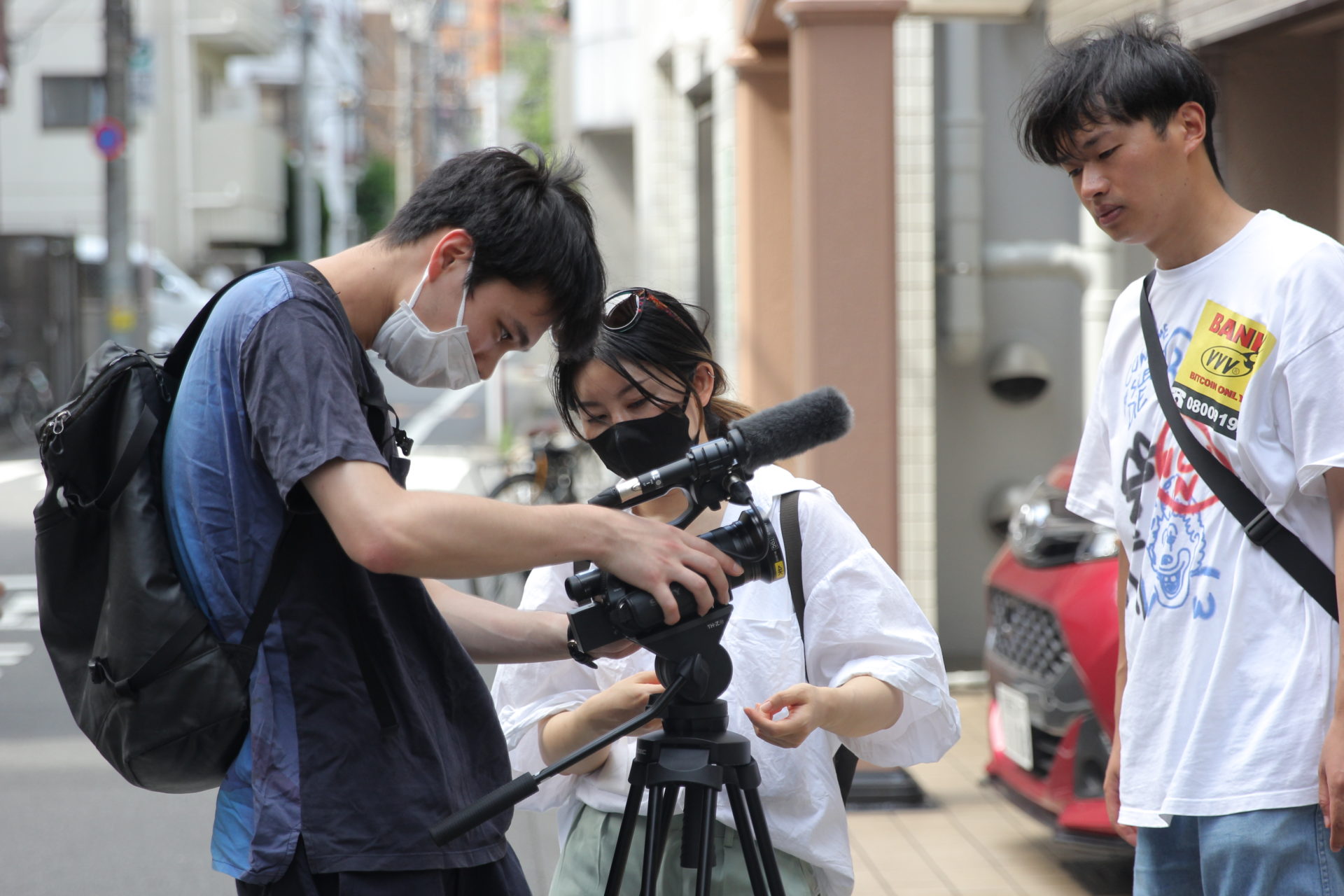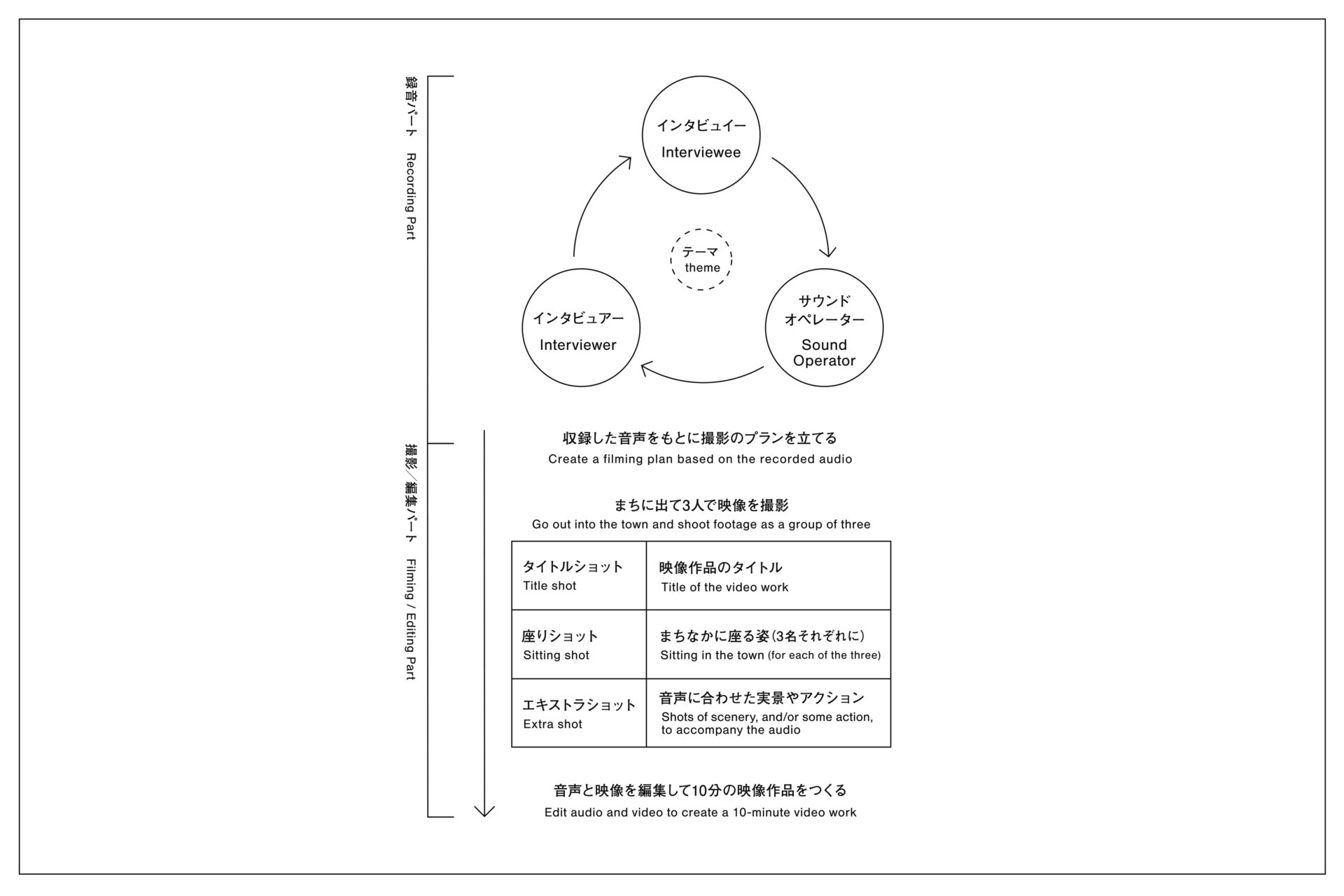
手法2:トライアングルインタビューMethod 2: Triangle Interview
トライアングルインタビューのルールThe rule of Triangle Interview
「シネマポートレイト」を経て見えてきたグループ内の3人の共通点から“テーマ”を導き出し、それをもとにした映像作品をつくる。録音パートでは、「シネマポートレイト」と同様に役割をローテーションしながらインタビューを実施。録音ブースを設けて本格的な音声収録を行う。そして、収録した内容に応じてどのような映像が必要になるかを考えながらまちなかでの撮影のプランを立てる。撮影パートでは、ビデオカメラを用いて3種のショットを撮影することを必須条件とする。
・タイトルショット:まちなかにチョークで書いた作品のタイトル
・座りショット:グループ内の3人それぞれが、まちなかで座った姿
・エキストラショット:実景(風景の映像)や「座り」以外のアクション
編集パートでは、編集ソフトを用いた作業をグループ内で行う。3人がインタビューで語った音源と、まちなかで撮影してきた映像を組み合わせて10分の映像作品をグループで一本完成させる。Deciding on a certain “theme” from the commonalities among the three members of the group that came to light through the “Cinema Portrait” session, a video work is created based on this theme. In the recording portion, interviews are conducted in the same way as in the “Cinema Portrait” session, with the participants rotating roles. A recording booth is set up for full-scale audio recording. Then, the participants will make a plan for the group to film in the city, considering what kind of images will be necessary according to the recorded content. In the filming part, the participants are required to take three types of shots using a video camera.
- Title shot: The title of the work written in chalk on the street.
- Sitting shot: Each of the three members of the group sitting down in the street.
- Extra shot: A shot of a real scene (scenery) or an action other than “sitting.”
In the editing part, the group will work together using editing software to complete a 10-minute video work by combining the three participants' interviews and the footage they shot in the town.

トライアングルインタビューの作品The works of Triangle Interview
「トライアングルインタビュー」は、「シネマポートレイト」で拾い上げた断片的なエピソードをさらに深堀りし、映像表現へと発展させていくプログラムである。
「シネマポートレイト」を経て関係が生まれた3人の間で共通点を見つけ、作品のテーマを導き出すプロセスは、自身のルーツを他者の視点で見つめ直す機会にもなる。テーマ決定後に行うインタビューの録音は、路上で短時間で行う「シネマポートレイト」での録音作業とは異なり、録音ブースを設け、椅子に腰掛け時間をかけて行う。そうして、より深く細かくそれぞれの語りを収録する。
一方で、それらの語りに応じた映像の撮影・編集は、“記録”というよりも“創作”という意味合いが強くなる。加えて、ビデオカメラを使用することで、表現の選択肢も広がり、参加者たちの表現者としての姿が現れてくる。しかし、実際にビデオカメラの扱いには相応の技術が必要で、多くの未経験者にとってはハードルにもなり得る。そこで「トライアングルインタビュー」では、ショットの種類をルールとして定め、短時間で作品制作を実現させるためのフレームを設けている。
ただし、それらは参加者の自由を奪うためではない。例えば「座りショット」として定めたルールは、まちなかで被写体として座る機会をつくり、まちとの関係を意識し、更新していくきっかけをつくる。そうして制作された作品は、東京というまちの現在の姿と、さまざまなルーツをもつ参加者たちの姿を映像として同時に映し出し、その二つの存在の新しい接続点を垣間見せる。The “Triangle Interview” is a program to develop the episodes from “Cinema Portrait” into a visual expression by digging deeper into them.
The process of finding commonalities among the three members, who have developed a relationship through “Cinema Portrait,” and deriving a theme for the film, provides an opportunity to look back at one's own background from the viewpoint of others.
The recording of the interviews after the theme has been determined differs from the “Cinema Portrait” process, which is done in a short period of time on the street, in that a recording booth is set up, and there the participants sit in chairs and take their time to speak. In this way, each narrative is recorded in greater depth and detail.
On the other hand, the filming and editing of the video in response to these narratives is more a “creative process” than a “recording.” In addition, the use of a video camera expands the options for expression and reveals the participants as expressive individuals. However, using a video camera requires a certain level of skill, which can be a hurdle for those who have not had the experience. Therefore, “Triangle Interview” sets rules for the types of shots and frames to realize the work in a short period of time.
However, they are not intended to take away participants' freedom. For example, the “sitting shot” rule creates an opportunity for each individual to sit down as a subject in the city and to renew their awareness of its relationship with the city. The work created in this way simultaneously shows the current state of the city of Tokyo, and the participants' various backgrounds in the city, and provides a glimpse of a new point of connection between the two entities.

